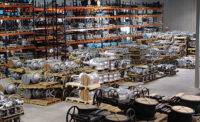Over the past few years, the wholesale industry has made serious advancements in technical efficiency, computerizing accounting and warehousing operations, for example, and integrating business processes. There is one function, however, that's been left out of the mix more often than not: production of the product catalog.
Some wholesale distributors have yet to incorporate catalogs into their sales mix at all, saying that catalogs are too expensive and too hard to keep up-to-date. They have a point. Wholesalers and distributors that outsource the production of their catalogs typically pay anywhere from $25,000 to $37,500 for the design of a 250-page catalog. And those catalogs are outdated almost before they're even printed. To gain more control over the content of their catalogs, and to avoid the large cash outlay of outsourcing, some choose to produce their catalogs themselves.
Such was the case for HVAC wholesale distributor, Ace Supply, based in Eagan, Minn., which for years produced its own catalog using a word-processing application. It was a labor-intensive, time-consuming process, and because of that the company only printed new catalogs once every couple of years. When Ace Supply began looking for a cost-effective way to improve the efficiency of its catalog process, the wholesaler determined that outsourcing wasn't the answer.
“There are many companies that offer catalog development for people, but they're costly and then you're constrained to that third party to compile your information into their catalog format,” says Greg Vogel, technical and information services manager at Ace Supply. “Oftentimes they require you to provide all the materials and data you would like to have compiled. With that in mind, we figured that if we had to provide the data and information, we might as well find something that will let us compile the catalog ourselves, and display it in the media we wanted.”
What the company found was Catalog Builder software from Computer Pundits Corp. It has been using this software for nearly five years now, which puts Ace Supply a step ahead of the pack when it comes to modern catalog design and distribution.
Robust, Yet Simple
Catalog Builder is a catalog management system for building, designing and maintaining catalogs in-house. Pulling from a single database, Catalog Builder can be used to generate print catalogs, PDF files, and searchable CD-ROM and e-commerce catalogs. Ace Supply uses Catalog Builder to output the pricing pages that are inserted into its sales department's three-ring binder catalogs. The wholesaler also generates its own searchable digital catalogs (with hyperlinked Table of Contents) that customers can access 24/7 on the Ace Supply Web site or browse on CD.While the technology behind Catalog Builder is robust, the user interface is intuitive and simple to use. “If someone can use basic word processing or presentation applications, he or she can use Catalog Builder,” says Michael Jacobs, Computer Pundits technical director. To attest to that, Computer Pundits has more than 35 patents pending on various user-friendly innovations built into its product.
Because Catalog Builder makes it easy to supply quality catalogs to customers, and at much lower costs than outsourcing, both the American Supply Association (ASA) and the Heating, Airconditioning & Refrigeration Distributors International (HARDI) Center for Advancing Technology recognized the value it could bring to their members in the PHCP and HVACR industries. In late 2003, the ASA announced that it would be working with Computer Pundits to provide in-house catalog creation capabilities in conjunction with its Industry Database (IDB), a continuously updated source of information on more than one million products.
“Catalog Builder brings a lot of value to the table for our members who produce or want to produce catalogs,” says Kevin Price, director of the ASA Center for Advancing Technology. “This is a great extension of the service we've provided with the Submittal Builder utility in the Source e-catalog, but with the power and flexibility to be used in building large catalogs from the IDB.”
Catalog Builder users construct their catalog database by importing information like part numbers, product descriptions, pricing and so on from their inventory management system, then modify and expand on it as necessary with images, specifications, and even benefit statements if desired. To fill in the gaps, they can pull from a number of sources, including the IDB and manufacturers' catalogs and Web sites. Once this task is complete, users select the information they want displayed and choose fonts, colors, and other design elements to create the customized look and feel of their catalog.
The set-up process is a one-time deal. All of the output formats - print, PDF, CD-ROM, e-commerce, whole catalogs and mini-catalogs - will be generated from this single database. Modifications and additions can be made continuously. And by synchronizing the database with the inventory management system using Catalog Builder's Update Feature, changes in pricing or availability are automatically updated.
According to Vogel, the ease of dealing with changes in list pricing has had the largest impact on the wholesaler's ability to provide customers with convenient access to up-to-date product information. “The No. 1 benefit to us at Ace Supply has been that when list prices change, I can update Catalog Builder and simply generate new catalogs on demand,” he explains.
So Many Choices
Many wholesalers and distributors aren't prepared to go paperless. They want to keep filling that spot on their customer's shelves. At the same time, having electronic options is appealing because digital output can be updated more frequently and cost effectively than print and provide customers with new conveniences like online browsing and automatically generated purchase orders. Here are some advantages to consider for each of the output options:
- Printed catalogs. In spite of the fact that we're operating in a digital world where data is zapped back and forth at the tap of a finger, many customers still like to see that data in black and white and hold it in their hands. Maybe they operate out of a truck and don't have access to digital media, for example. So, if you need to continue producing paper catalogs, Catalog Builder at least lightens the load by automatically generating the Table of Contents, formatting, and printing the specified categories of information, including product images and graphics, in a professional quality manner.
- PDF catalogs. To view PDF (portable document format) files, customers must have Adobe® Acrobat loaded on their system. Most everyone does these days, but if not, it can be downloaded for free off Adobe's Web site. A PDF catalog looks exactly like your printed catalog. The formatting, images, and colors all stay the same. The advantage is that it's electronic, so you can email it and get it in your customers' hands in just seconds rather than the days it can take going through the mail. You save postage costs too. You can also choose to include your PDF catalog on your Web site so customers can get to it whenever they want. PDF catalogs can be viewed on-screen or printed out.
- CD-ROM catalogs. By distributing catalogs on CD-ROM you retain the same control over who receives your catalog and when they receive it as you have in hard-copy distribution. The difference is that at less than a dollar a catalog, you can update and distribute CD-ROM catalogs much more frequently and cost-effectively than you can hard-copy catalogs. Another benefit is customer convenience. The CD-ROM catalog provides an interactive interface so that customers can browse through menus and have the category of product they're interested in presented to them in just a few clicks of the mouse. You can even provide customers the convenience of generating job estimates, purchase orders, and quotations electronically from your catalog rather than writing them up by hand.
- E-commerce catalogs. In this case, you provide your customers with the same interactive, convenient experience as with CD-ROM catalogs, except that they are browsing your catalog on the Internet. You don't have to send them CDs. They don't have to find and load the CD. You can take advantage of shopping cart technology to give your customers the ability to submit purchase orders or even complete the entire purchase transaction online.
When it comes to any technology purchase, flexibility and usability should be key decision factors. The fact that average computer users can use Catalog Builder to design and produce catalogs in all of the mediums described above demonstrates how flexible and user-friendly it is. It is capabilities like these that have convinced Vogel that Catalog Builder can't be beat. “I haven't seen anything comparable that lets you be in control of your catalog real-time like Catalog Builder does,” Vogel says. “Through discussions with others in the industry, I see they're still faced with the old-fashioned compilers who want to produce large quantities of catalogs at a time. That simply doesn't accommodate for changes.” <<


